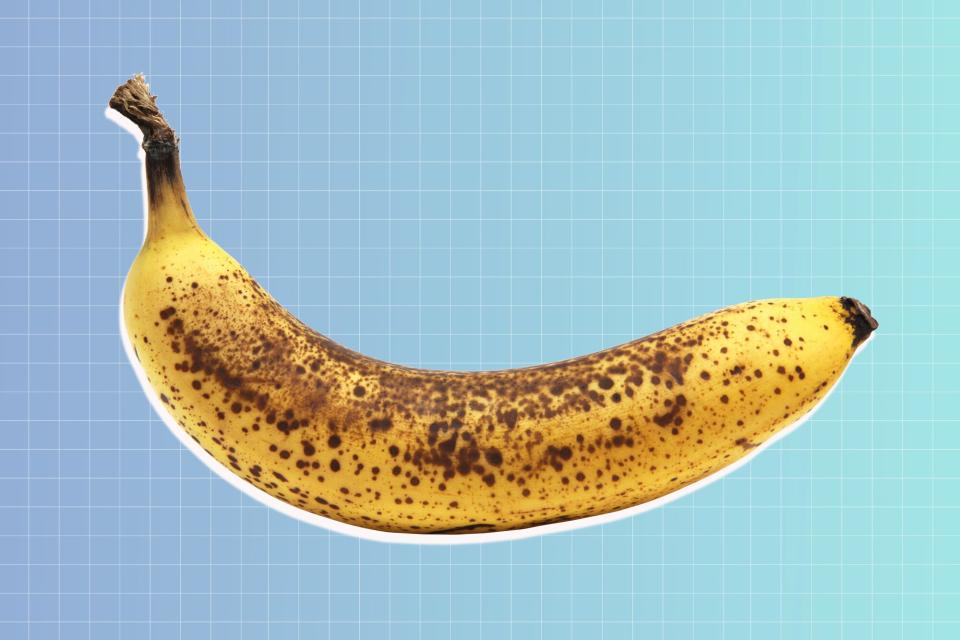Do Bananas Lose Fiber When They Ripen?
Bananas change in flavor and appearance as they ripen. But do they change in their nutritional constitution? As they go from green and firm to yellow and soft, do they lose some of their fiber content? Not exactly. Monica Auslander Moreno, M.S., RD, LDN, founder of Essence Nutrition in Miami, says, "[A banana] doesn't lose fiber, but the fiber changes as the banana matures. It goes from having more to less resistant starch."
Resistant starch is a type of prebiotic fiber mostly found in foods like grains, potatoes, bananas and beans. As the name implies, these starches resist being broken down in your digestive tract. This allows them to remain intact until they reach the large intestine, where they can be used as fuel for the good bacteria in our gut. In the Encyclopedia of Food Chemistry, the authors characterize resistant starch as "reaching the colon either unchanged or slightly changed." Resistant starch, which has five different subgroups, interests researchers because it may help reduce the incidence of inflammatory bowel diseases, like ulcerative colitis and Crohn's disease, as well as colon cancer.
In addition, a 2020 study published in Nutrition Journal indicates that consuming resistant starch might play a role in reducing inflammation in the body in general. This could be helpful for a variety of chronic conditions, including cardiovascular disease, nonalcoholic fatty liver disease, type 2 diabetes, obesity and metabolic syndrome, although the authors of the study caution that further investigation is warranted.

Getty / subjug
As a banana ripens, the structure of its carbohydrates breaks down from prebiotic fibers and pectin to sugar. For example, a fully green banana contains more than 3 grams of fiber, while an overripe banana possesses less than 2 grams of fiber. The amount of total carbohydrates in a banana remains consistent, regardless of its ripeness level. But the change in fiber content can be attributed to the transformation of its carbohydrates as it ripens. The values of other nutrients, such as potassium, vitamin C, protein and fat, remain consistent at any stage of ripeness.
Another thing that changes as a banana ripens: its satiety factor. This means that eating a ripe banana versus eating a greener banana can have different effects on your appetite. Moreno says, "A super-ripe banana is perfect for baking. But unless you're baking with them, I recommend the more underripe bananas to harness more of that prebiotic fiber." Prebiotic fiber has a filling effect, making you feel more satisfied for longer. That said, the flavor of completely green bananas may not be as appetizing as that of ripe bananas, so aim for a happy medium. If a banana is getting past its prime, it might be better suited for banana bread than for an afternoon snack.
And while the sugar content may seem high, the glycemic index of ripe bananas is actually rated low at 51, with slightly underripe fruit (think: yellow with some green sections) scoring even lower at 42. This means that bananas will help keep your blood sugar levels more consistent (compared to higher-GI foods), while avoiding large spikes and crashes. This could be due to the amount of resistant starch in the fruit, which moves through the small intestine without much absorption into the bloodstream. Bananas, therefore, are a good food choice for people with diabetes or others trying to watch their blood sugar levels.
Many of us may think that bananas should be completely yellow by the time we eat them. But bananas are healthy and safe to eat at any stage of their development. The next time you reach for one, remember that a banana that's a little green might have slightly more gut-friendly fiber than one that's completely ripe or overripe (those might be better for one of our healthy banana dessert recipes).

